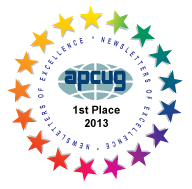A team working together is greater than the sum of its parts. Chuck introduced Dr. David P. Anderson of BOINC.
The purpose of BOINC is to increase the usage of volunteer computing to meet the scientific need for high-throughput computing. Scientific computing reaches a point where one computer cannot do the job. One type of supercomputing solution involves rewriting the process so that the job runs faster. Another kind of solution distributes the work over many computers and is more effective where speed is not so important but a large number of FLOPS (Floating-point Operations Per Second) are needed, as in climate modeling.
Volunteer computing has been around since 1995. SETI@Home launched in 1999. BOINC is a general-purpose middle-ware program for volunteer computing, allowing for automatic updates.
BOINC lets users select when their computer will participate, how much of their computer’s resources will be devoted to the projects, and which projects they will participate in. The general public learns more about science, scientists are encouraged to improve their research as well as their efforts to educate the public. Currently about 500,000 people participate in BOINC. The equivalent supercomputer would cost $400,000. The industry is about 10 years away from developing a single exaFLOP computer with equivalent computing power.
BOINC has projects in the fields of biology, medicine, physics, astronomy, environment, and mathematics. Developed by Carl Christianson, climateprediction.net is based at Oxford University runs climate simulations. The purpose of Einstein@home is to analyze data that would demonstrate gravitational waves. SETI@home is also looking for a sine wave against a background of noise; the range of possible variations is computationally intensive. Milkyway@home is analyzes data to improve the mapping of the Milky Way, including dark matter. GPUGRID.net maps proteins. AQUA@home is operated by D-Wave Systems, a Canadian company, to develop a quantum computer. Quake Catcher Network is a distributed seismograph. Carl developed Quaker Catcher, also. Fortunately he’s at the meeting and can be asked director about both climateprediction and Quake Catcher.
BOINC is currently working on developing virtual machine operations. The open-source Virtual Box interfaces with many platforms. A virtual machine reduces security exposure. BOINC uses strong security encoding. Also on the horizon are umbrella projects, such as the IBM World Computing Grid, that coordinate the computing power and scientific projects. Dr. Anderson has a long-range goal of a combined model that would be directed by an agency such as NSF.
Volunteer computing has economic advantages over other forms of high-throughput computing and has the secondary advantage of increasing public awareness of scientific activities. As mobile devices grow in power, their resources will be tapped.
Several companies have tried a paid model of distributed computing. These have not been successful because the companies, such as pharmaceuticals, that would fund this kind of project employ proprietary data that they do not want to download to volunteer computers.
The motivations of volunteers have been studied. One set of motivations revolve around the desire to support a scientific venture. Another group is competitive about the power of the computers they bring to the projects and the credits they earn.




